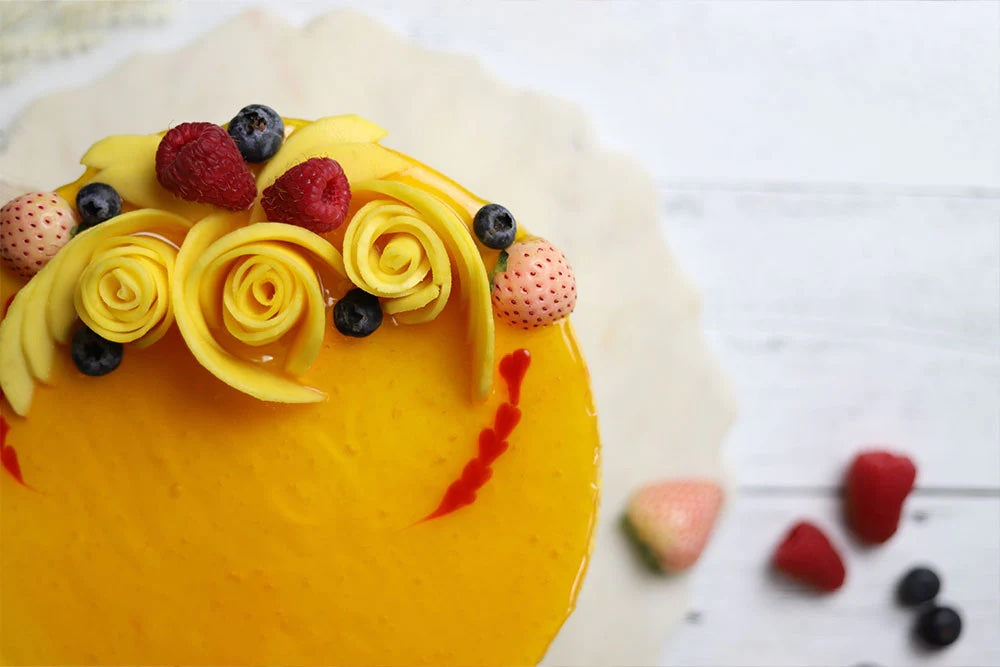
You've Got Great Taste: Using Flavorings to Create Delicious Flavor Profiles

Pictured Above: Using purées, concentrates, and other flavorings can significantly enhance the taste and complexity of desserts, such as the layers of fruity, refreshing mango and passionfruit filling in this No-Bake Cheesecake.
By Jimmy MacMillan
In the world of desserts, where flavor reigns supreme, the art of crafting delicious profiles is akin to painting a masterpiece. In this comprehensive guide from professional pastry chef Jimmy MacMillan, we delve into the enchanting realm of using flavorings to elevate your sweet creations to new heights. Whether you are an experienced pastry chef or just starting out, the journey to crafting desserts that tantalize the senses is one filled with exploration, experimentation, and the endless possibilities that flavorings bring. Read on to explore and unlock the secrets to creating desserts that are as memorable as they are mouthwatering.
Enchanting Desserts with Flavorings

I have worked most of my life in pastry and have always been quality minded. I spend time and energy to provide the best quality of dessert. It is not essential to me if the dessert will be served in a restaurant or café, in a hotel, or purchased from an in-store bakery. In every instance, I believe the dessert must taste great, have great texture and bring pleasure to the person consuming it. At times I hesitated to use pre-made purées, concentrates, pastes, and other flavorings as I did not want to sacrifice the quality of the product.
In some instances, using fresh products isn't an option, as in candy making, and certain flavors will be hard to recreate from fresh materials. As the quality and number of flavor houses (companies that manufacture flavor products) increase, I've discovered ways that these products can open possibilities for creating delicious dessert taste profiles.
It can also be challenging to decide which flavor is best among fruit purée, flavor compound, flavor paste, extract, or other flavorings. For example, there will be one or two versions of strawberry flavor in each form and multiple product lines from various manufacturers. It takes time to sort through the options. As a guideline, I use the best quality brands with the most consistent products across their line.
Fortunately, I have had time to work with many different flavorings from many flavoring houses and can offer some excellent suggestions. In general, some manufacturers have great fruit flavors, and other have excellent flavors of chocolate, coffee, nut and caramel.
Where to Start
Flavorings have a broad application and, with guided selection, can be used to enhance most recipes. Like any ingredient, the selection process is essential. How do we know when to use a purée versus a compound or an extract?
As a guideline, the amount of water needed in a recipe and the amount of solids available can indicate which direction to go with flavorings. Quality extracts and oils are nearly essential for ratios with high water content where solids aren't present. Be sure to note water soluble or oil soluble extracts based on whether the formula is mostly water or if fat is present where oil soluble flavors can be adequately dispersed in the finished product. Solubility is the ability of an item to dissolve into another item, in this case, water or oil (fat).
Fruit Purées
There are many excellent fruit purées available in the market. Many of the best purées are imported from Europe, but there are also respectable North American producers. Fruit purée most resembles the source fruit and ranges from a thin, pourable liquid to a thinner liquid resembling water. Fruit purée flavors are plentiful, and multiple options exist for red, yellow, stone, and orchard fruits.
Fruit purées may contain many solids based on their source fruit. Traditionally, fruit purées contain 10% sugar to help preserve the purée and delay oxidation, but in recent years high-quality manufacturers have eliminated the sugar. As they are shipped and stored frozen, fruit purées must be thawed and stirred before being used in recipes to ensure consistency. Fruit purées have a relatively short shelf life of 5-7 days refrigerated. Fruit purées can be frozen again after thawing with little degradation.
View ifiGOURMET's selection of Fruit Purées here. Need some inspiration? Check out our selection of recipes that incorporate fruit purée, from ice creams and sorbets to fruit jellies, jams and more.
Pictured Above: Fruit purées are an excellent way to add flavor, aroma and color to a variety of recipes, such as pâte de fruits, fillings for macarons, replacing oil or butter in baked goods, infusing icing, or adding them to ice creams and sorbets, like this Mango and Orange Blossom Sorbet (Image courtesy of Léonce Blanc).
Nut Pastes
Nut pastes are emulsified products that range in thickness from pourable to soft solid and may be used for dessert applications where nut profiles are desired. Standard nut pastes are pistachio, almond, and hazelnut, which can sometimes be mixed with chocolate. The source of the nut can identify nut pastes, the percentage of the nut in the past, how roasted the nut is, and how much oil, sugar, and other ingredients are present. Sometimes nuts will be combined with chocolate. Most nut pastes are shelf stable in a dark, cool place but often can be found refrigerated in warmer climates. It is crucial to mix nut purées thoroughly before using so that as the product is consumed, recipes have the proper amount of oil and nuts.
View our full selection of Nut Pastes here.
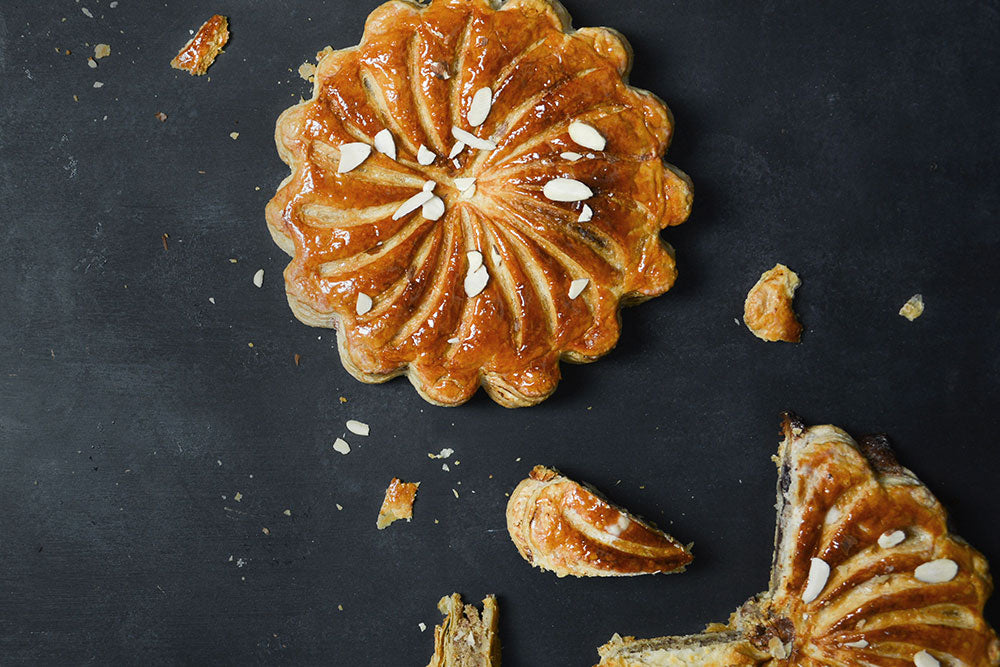
Pictured Above: High-quality nut and praline pastes are perfect for adding flavor to confections, ice cream, and pastries, such as this Almond Pithivier.
Flavor Compounds
Sometimes called Flavor Pastes, flavor compounds come in many flavors ranging from citrus to floral and may contain alcohol and other ingredients. Generally thinner than fruit purées or nut pastes, the advantage of flavor compounds is they are concentrated and contain much less water or oil.
Some flavor compounds are designated as baking pastes for baked items such as muffins, cakes, and pound cakes. Other compounds are inappropriate for oven applications and may change color during baking. Color is sometimes added to compounds to add visual appeal. Flavor compound manufacturers will advise whether they are natural and bake stable, and the recommended usage may range from 3%-5%. The dosage for any flavoring is only a guideline, and starting on the lower side of the range is recommended.
View our extensive selection of Flavor Pastes here. For inspiration on the many ways to use Dreidoppel's versatile concentrated flavoring compounds, check out our blog post or view our collection of recipes here.

Pictured Above: Combining Flavor Pastes is a great way to build layers of flavor and add irresistible appeal to desserts, such as these Flavored Crinkle Sandwich Cookies in pairings like Blueberry-Lavender and Raspberry-Lemon.
Extracts
Extracts may be used to add concentrated flavors to desserts. Although available in several forms, most commonly, extracts will be sold as a liquid in a base of water, alcohol, and occasionally oil or gums. Extracts may be labeled as pure, natural, or artificial. Pure extracts are made from the natural source of the flavoring agent, while natural extracts are made from the natural source but may contain other ingredients. Artificial extracts are made from synthetic ingredients. Standard designations for extracts can be "N" for natural, "A" for artificial, and "N/A" for combining natural and artificial.
View our selection of Extracts here.
Essential Oil 
Essential oils are the highly concentrated, volatile, aromatic essences of plants. These natural plant oils are appreciated for both their aromatic and flavoring qualities. Many essential oils, such as peppermint, lemon, and orange, are commonly used to flavor desserts, candies, and chocolates. Lavender and bergamot oils, for example, may be used in chocolate making.
Highly Concentrated
Due to the highly concentrated flavors of extracts and oils, recommended dosages range from .5% to 1%, with super concentrated products only requiring .1 to .3%. Using droppers and microgram scales can help maintain and control the dosage in your food operation.
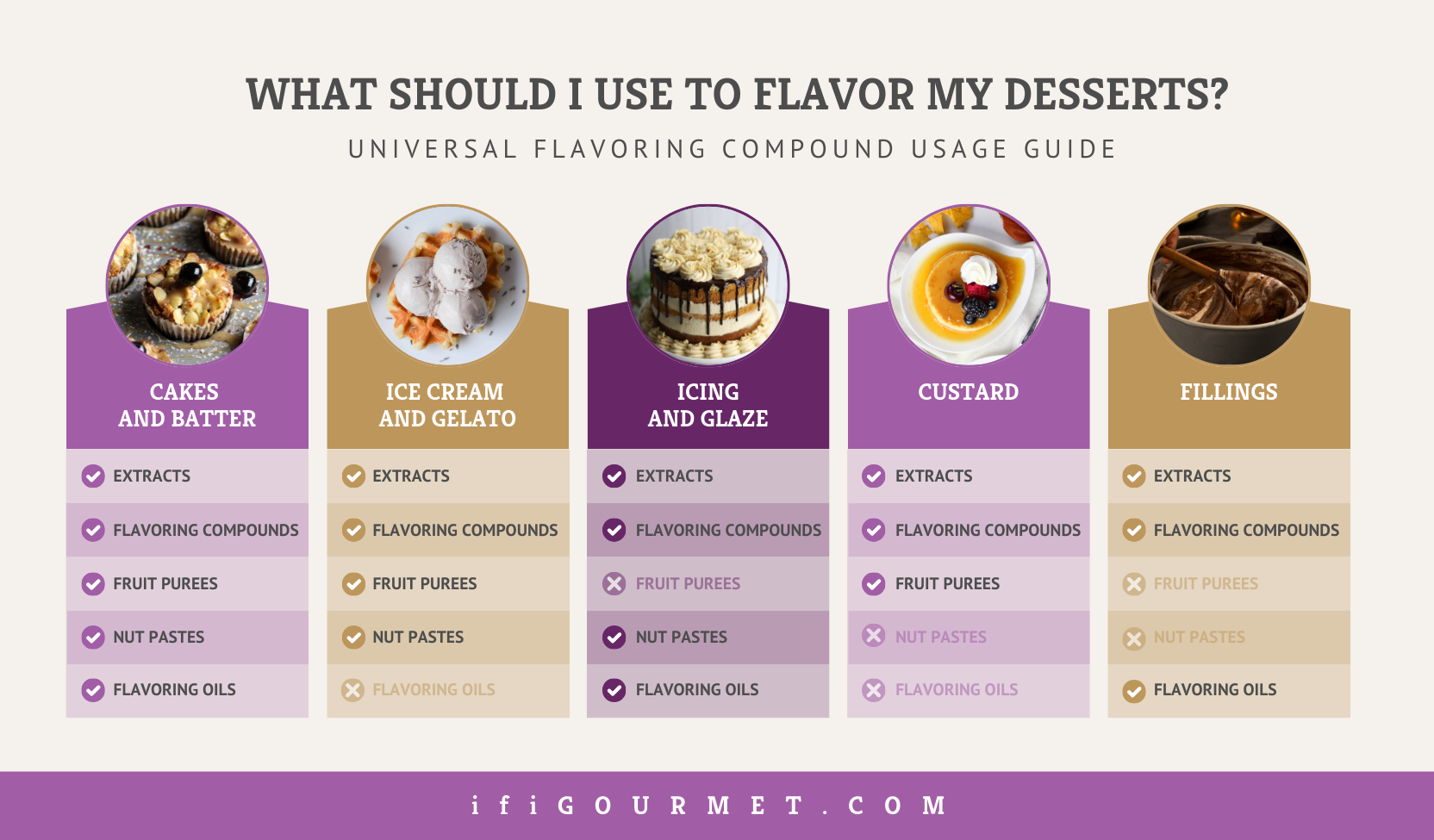
Layers of Flavors 
Armed with an understanding of these flavorings, we can find numerous applications. These flavorings can build layers of flavor by incorporating different forms of flavorings. For instance, you could use fruit purée as a filling, a compound in syrup for soaking cake layers, and a nut paste as a glaze or topping. Layering these flavors creates a more multi-dimensional and enjoyable dessert experience. Flavorings can add complexity to a recipe, such as using a combination of berry purées and a touch of lemon oil can create a dessert with layers of fruity and tangy flavors. Flavor compounds and extracts are concentrated flavorings and can be used tastefully to intensify the taste of your desserts. The most relatable example is how a small amount of vanilla extract can elevate the flavor of a plain cake or custard.

Pictured Above: Layering flavors creates a more multi-dimensional and enjoyable dessert experience - such as the Rose simple syrup soaked cake layers adorned with Rose, Pistachio, and Vanilla Bourbon buttercream in these Mini Rose Cakes.
Flavor Infusions or Fillings
Incorporating concentrated flavors or pastes, such as creams, mousses, or ganaches, enhances the taste of your dessert fillings. These flavorings can add depth and complexity to your dessert, making it more memborable. For instance, you can mix mango purée with passion fruit concentrate and add it to fillings for a tropical twist or combine coffee flavor paste with hazelnut paste for a rich and indulgent flavor. Remember to taste and adjust the amounts of these flavorings to achieve the desired taste profile. Don't be afraid to be creative and try new combinations to create unique and delicious desserts.
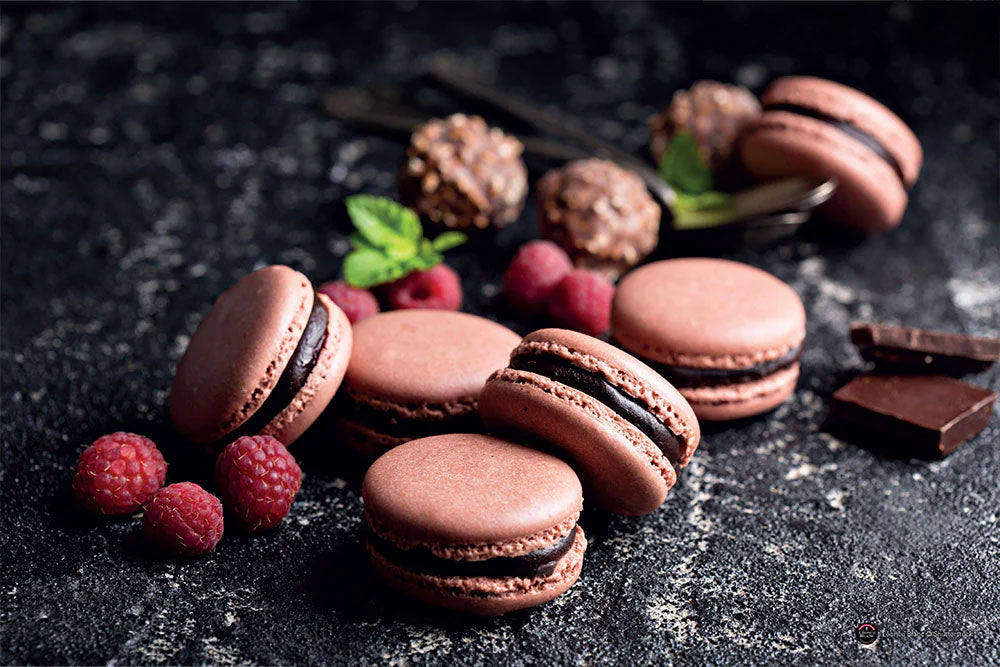
Pictured Above: Incorporating flavorings such as fruit purées or Flavor Pastes into dessert fillings can add depth to your sweet creations, making them more memorable. Pictured: Chocolate and Raspberry Macarons (Image courtesy of Léonce Blanc).
Creative Combinations
Create visually appealing desserts by swirling or marbling different purées or flavor pastes into your dessert batter. This technique works well with cheesecakes, muffins, or ice cream. Use purées, concentrates, or pastes as a base for making delicious sauces or glazes. For example, you can simmer a fruit purée with sugar and reduce it to create a flavorful fruit sauce that can be drizzled over cakes, pancakes, or ice cream, or add mango compound to a neutral glaze to add color and flavor on top of a cheesecake.
Balance Sweetness and Acidity
A balanced flavor profile is crucial in desserts. Some purées or concentrates may be sweeter or more acidic than desired. Add sugar, lemon juice, or other balancing ingredients to adjust sweetness or acidity levels. Pair tart purées, like passion fruit or lemon, with sweet concentrates like vanilla or caramel to create a harmonious flavor combination. Citrus purées or concentrates, such as lemon or lime, can add acidity with a tangy and refreshing element to your desserts. Use them to balance the sweetness and add a bright note to your dishes.
Creating Textures
Depending on your desired consistency, you may need to adjust the number of purées, pastes, or concentrates you use. Opt for purées or concentrates if you want a smooth and creamy texture. Pastes can be great for a thicker consistency with more pronounced flavors. Consider how different textures can compliment the overall dessert experience.
Purées and pastes can add moisture to desserts, so adjust your recipe accordingly. For example, if you're adding fruit purée to a cake batter, reduce the amount of liquid, adjust the baking time to ensure the right texture, or fold in a nut paste to add a denser texture to a mousse or custard filling.
Versions and Versions
Creating a balanced and delicious dessert profile takes practice and experimentation. Feel free to try new combinations and adjust the ratios of flavorings until you achieve the desired result. Taste, evaluate, and refine your recipes to improve over time. Remember, the key to building a delicious dessert profile using purées, pastes, concentrates, and other flavorings is to balance the flavors, consider the texture, and experiment with different combinations. Enjoy the creative process and explore the world of flavors in your desserts!
Consider Presentation
The flavor is not the only aspect contributing to a delicious dessert. Think about how purées, pastes, or concentrates can enhance the visual appeal of your creation. Swirls, drizzles, or layers of contrasting flavors can make your desserts visually enticing.
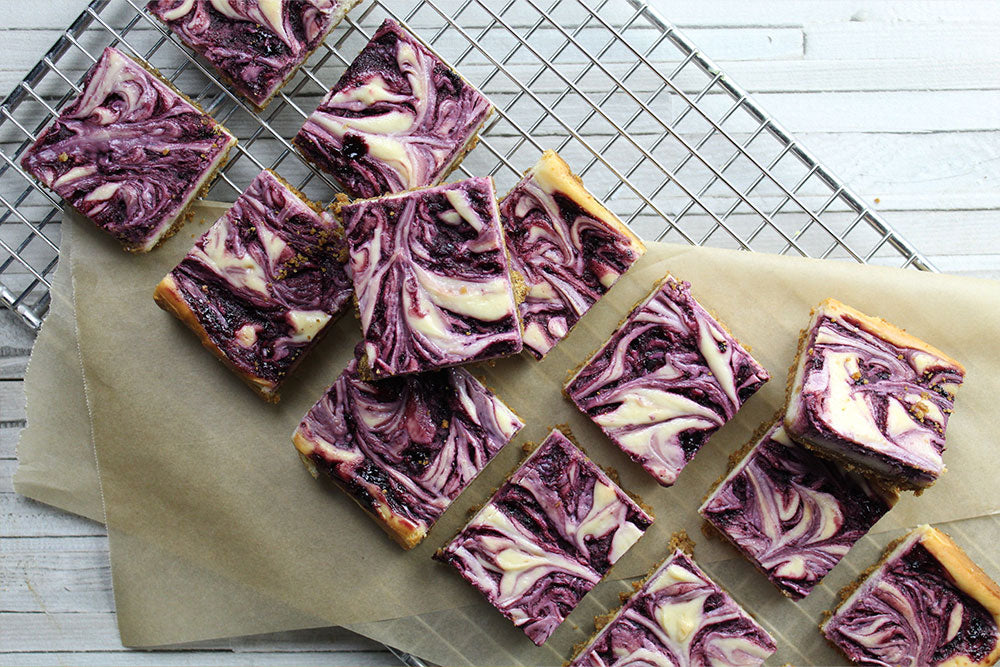 Pictured Above: In addition to flavor, purées, pastes, and concentrates can enhance the visual appeal of your sweet creations by adding swirls or layers of color.
Pictured Above: In addition to flavor, purées, pastes, and concentrates can enhance the visual appeal of your sweet creations by adding swirls or layers of color.
Final Words
Don't overpower the dessert! While flavorings can add a delightful twist to your desserts, avoid overpowering the dish with too many intense flavors. Use a light touch and let flavors shine without overwhelming the palate. Be bold and think outside the box and try unconventional combinations. Mix unexpected flavors like a chili-infused chocolate paste with a mango purée for a spicy-sweet dessert experience.
Remember, the key to creating a delicious dessert taste profile is to balance the flavors and let each component complement and enhance the others. Using purées, pastes, concentrates, and other flavorings can significantly enhance the taste and complexity of desserts. Start with small amounts, taste as you go, and adjust until you achieve the desired result. Happy experimenting!
Jimmy MacMillan is a celebrated pastry chef, food writer, and Emmy® award-winning video producer. His awards include Top Ten Pastry Chef, Rising Star Pastry Chef, and two James Beard Award Nominations. Chef MacMillan is a pastry consultant servicing the restaurant, hotel, manufacturing, and retail industries under the Pastry Virtuosity label. For more information, visit: www.PastryVirtuosity.com

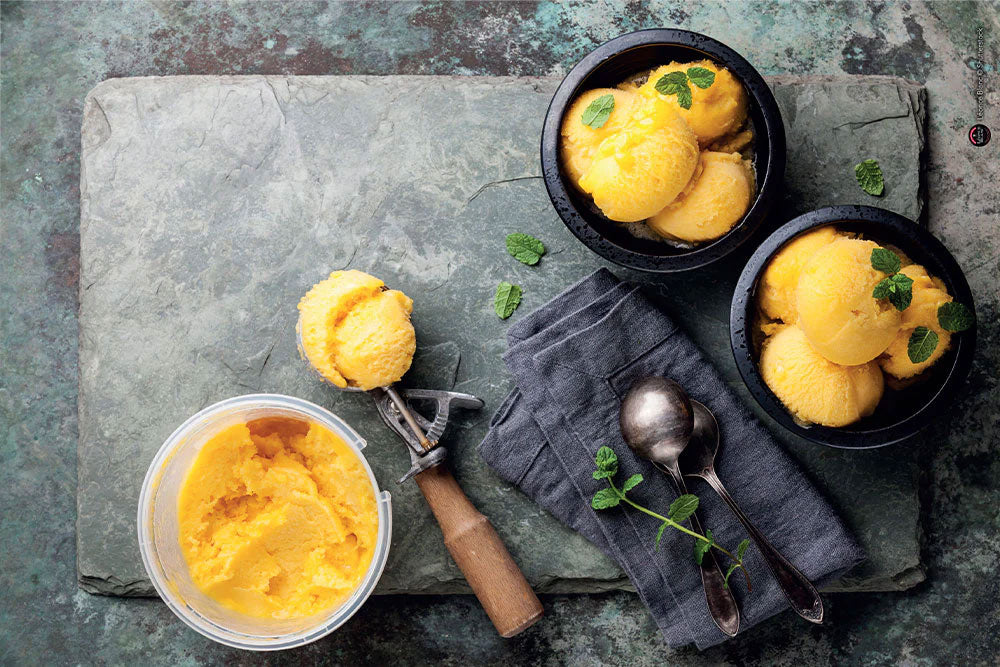
Leave a comment